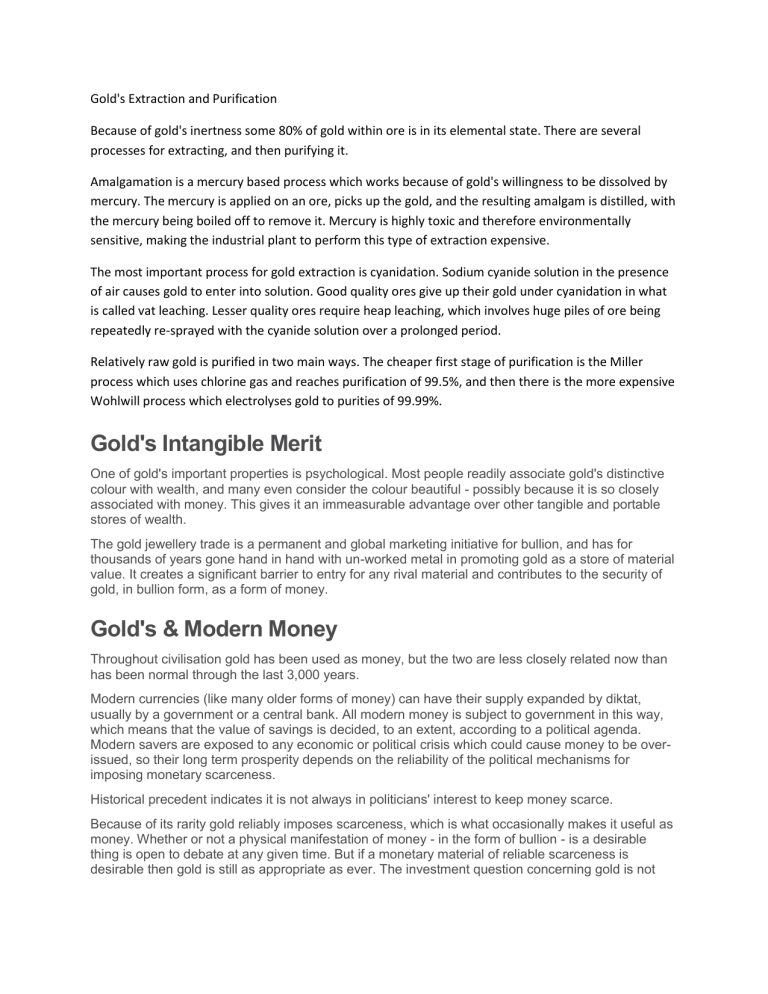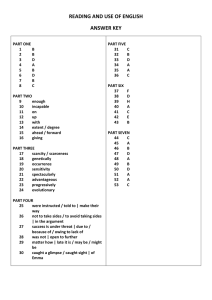
Gold's Extraction and Purification Because of gold's inertness some 80% of gold within ore is in its elemental state. There are several processes for extracting, and then purifying it. Amalgamation is a mercury based process which works because of gold's willingness to be dissolved by mercury. The mercury is applied on an ore, picks up the gold, and the resulting amalgam is distilled, with the mercury being boiled off to remove it. Mercury is highly toxic and therefore environmentally sensitive, making the industrial plant to perform this type of extraction expensive. The most important process for gold extraction is cyanidation. Sodium cyanide solution in the presence of air causes gold to enter into solution. Good quality ores give up their gold under cyanidation in what is called vat leaching. Lesser quality ores require heap leaching, which involves huge piles of ore being repeatedly re-sprayed with the cyanide solution over a prolonged period. Relatively raw gold is purified in two main ways. The cheaper first stage of purification is the Miller process which uses chlorine gas and reaches purification of 99.5%, and then there is the more expensive Wohlwill process which electrolyses gold to purities of 99.99%. Gold's Intangible Merit One of gold's important properties is psychological. Most people readily associate gold's distinctive colour with wealth, and many even consider the colour beautiful - possibly because it is so closely associated with money. This gives it an immeasurable advantage over other tangible and portable stores of wealth. The gold jewellery trade is a permanent and global marketing initiative for bullion, and has for thousands of years gone hand in hand with un-worked metal in promoting gold as a store of material value. It creates a significant barrier to entry for any rival material and contributes to the security of gold, in bullion form, as a form of money. Gold's & Modern Money Throughout civilisation gold has been used as money, but the two are less closely related now than has been normal through the last 3,000 years. Modern currencies (like many older forms of money) can have their supply expanded by diktat, usually by a government or a central bank. All modern money is subject to government in this way, which means that the value of savings is decided, to an extent, according to a political agenda. Modern savers are exposed to any economic or political crisis which could cause money to be overissued, so their long term prosperity depends on the reliability of the political mechanisms for imposing monetary scarceness. Historical precedent indicates it is not always in politicians' interest to keep money scarce. Because of its rarity gold reliably imposes scarceness, which is what occasionally makes it useful as money. Whether or not a physical manifestation of money - in the form of bullion - is a desirable thing is open to debate at any given time. But if a monetary material of reliable scarceness is desirable then gold is still as appropriate as ever. The investment question concerning gold is not whether or not it reliably imposes scarceness, which it does, but whether or not such reliable scarceness will in the future be required by savers. Because the significant majority of people currently believe that our governments and our central banks have sufficient skill to manage the supply of money, gold’s use as a monetary material has waned, especially over the last 70 years. This is a regular pattern. Gold will quietly slip into the background when paper money becomes widespread because, as the famous Gresham's Law says "bad money drives good money out of circulation". But part of the mystery of money concerns gold's cyclical re-appearance, which the following pages will aim to explain. The Chemical Characteristics of Gold Gold is a chemical element, so it can only be discovered and not made. It is essentially inert, meaning that: I it is almost entirely resistant to decay, (ii) it is not very helpful in any industrial / chemical processes that use it, and (iii) it is convenient for long periods to store cheaply. For its rarity, density, softness, and its very strong electrical conductivity, it is remarkable. A limited number of industrial applications emerge from its physical qualities, Gold finds. Usage is use It is used in dentistry and in the manufacture of certain electronics which require non-corrosive contacts of high quality. Its truly practical applications, however, are numerically unimportant. Of all the gold that was mined out of the Earth, much of it was used by us in these three ways: As a personal adornment, where its color and its wealth relationship lead to its use in the manufacture of jewelry (approximately 60% of the worldwide supply) Backing monetary regimes (~ 20 percent of the global supply) as a public store of resourcesThe Chemical Characteristics of Gold Gold is a chemical element, so it can only be discovered and not made. It is essentially inert, meaning that: I it is almost entirely resistant to decay, (ii) it is not very helpful in any industrial / chemical processes that use it, and (iii) it is convenient for long periods to store cheaply. For its rarity, density, softness, and its very strong electrical conductivity, it is remarkable. A limited number of industrial applications emerge from its physical qualities, Gold finds. Usage is use It is used in dentistry and in the manufacture of certain electronics which require non-corrosive contacts of high quality. Its truly practical applications, however, are numerically unimportant. Of all the gold that was mined out of the Earth, much of it was used by us in these three ways: As a personal adornment, where its color and its wealth relationship lead to its use in the manufacture of jewelry (approximately 60% of the worldwide supply) Backing monetary regimes (~ 20 percent of the global supply) as a public store of resources Gold is exceptionally precious. It is contained, according to all geological knowledge, almost exclusively at low rock concentrations. An exception is nuggets, but they account for the smallest portion of gold found. Interestingly, in seawater, there is even gold in solution, however while the overall amount is high (because the oceans are enormous), the concentration is poor and makes extraction beyond any practical technology. The cost of pumping 1,000 tons of seawater for processing must be taken into account.








